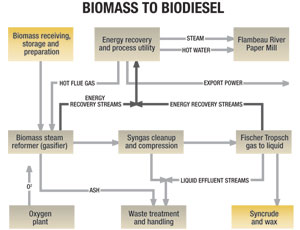A project under way to build a $250-million renewable-fuel plant in Park Falls, Wis., will eventually draw on about 1,000 tons of forestry waste daily and convert it into sulfur-free diesel.

“We will take bark, sawdust, wood chips and forest residue that wouldn’t be used for anything else and turn it into biofuel, wax, green electrical power, steam and heat that are useful,” says Bob Byrne, president of Flambeau River Biofuels.
The contractor expects to begin late this year, and the plant is expected to be in full operation by 2013. The project is partially funded by a $30-million grant from the U.S. Dept. of Energy.
The owner has selected London-based engineering firm AMEC and Neenah, Wis.-based general contractor Miron Construction Co. Inc. to design and build the facility under an engineer, procure, and construct (EPC) agreement.
“AMEC has been focused on the cellulosic industry for several years,” says Don Sorenson, vice president of AMEC’s domestic power and process business. Patrick Nate, Miron vice president, adds that he hopes to develop “specific methods for building this kind of facility efficiently,” as demand is expected to grow for cellulosic biofuels.
The conversion process grinds up various biomass feedstocks and heats them into a synthesis gas. The plant then cleans and compresses the gas, converting it into clean diesel and wax.
The plant is expected to produce 8 million gal of cellulosic biodiesel a year. In 2008, the U.S. consumed about 413 million gal of biodiesel, made mostly from food sources, according to DOE; total U.S. demand for petroleum-based diesel was 52.9 billion gal. Generally, biodiesel costs about 15¢ more than petroleum-based diesel. Flambeau has not yet released prices.
In addition to the diesel produced, waste gas will fuel the burners that heat the plant’s biomass-gasification chamber. Heat and steam will be recycled to generate 8 MW of electricity, some of which will be used in operating the plant.
In addition to supplying energy for its own needs, the plant will sell electricity, heat and steam to meet all the energy needs of an existing pulp-and-paper mill next door. It will become the first integrated pulp-and-paper mill in North America to run entirely on fossil-free energy, says Byrne.
The biofuel plant is employing a patented process from ThermoChem Recovery International, Baltimore. The process is about 500 hours into a 1,000-hour test at a pilot plant in North Carolina.
One indicator that m ore biorefineries might be sprouting up comes from a survey of some 200 experts at a recent meeting of the Technical Association for the Pulp and Paper Industry (TAPPI). Eighty-two percent of survey respondents said creating biofuels and other renewable products is a more effective use of biomass than simply burning it in boilers.
Nearly one-third of survey participants said their companies plan to integrate biorefinery capacity in the near future.

Post a comment to this article
Report Abusive Comment